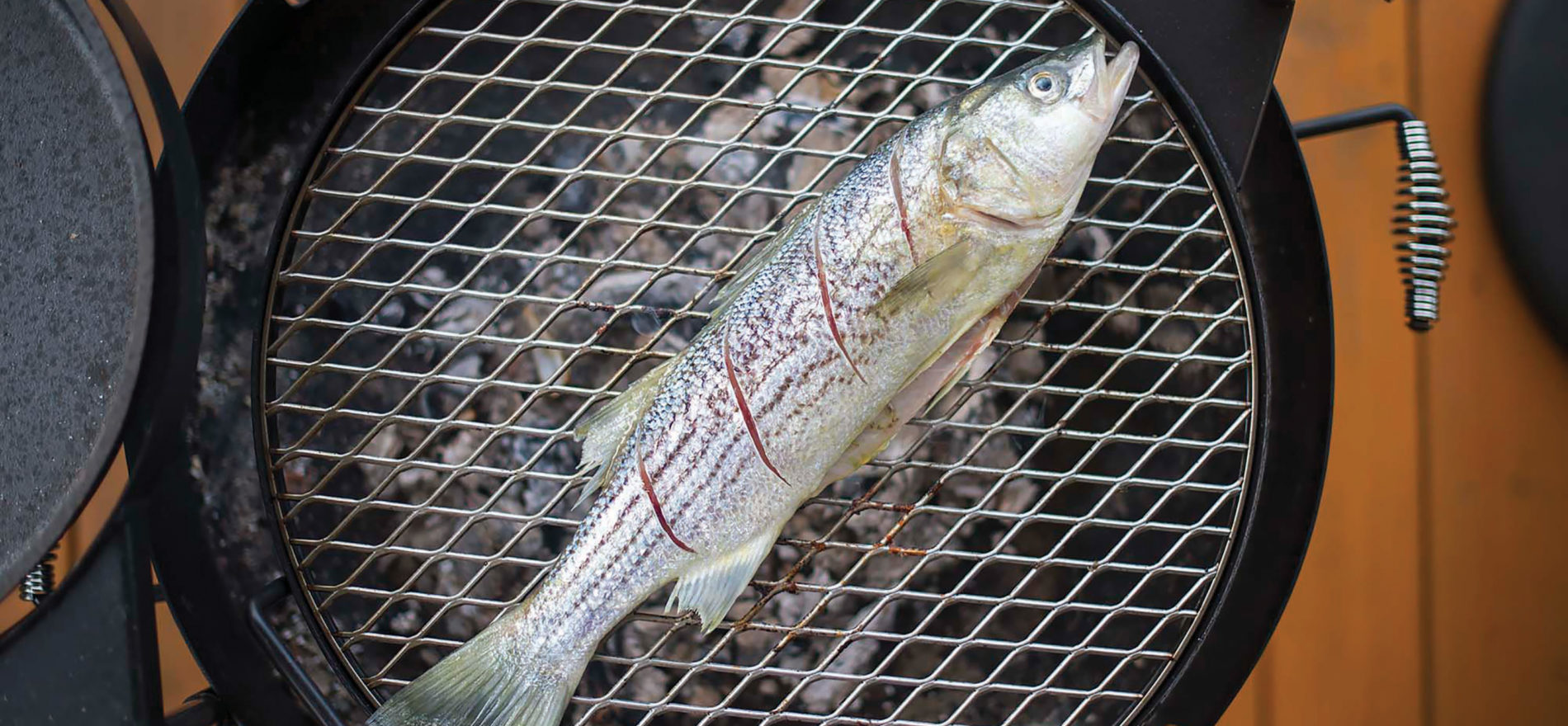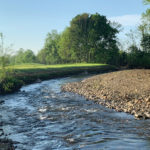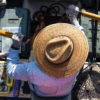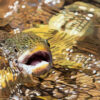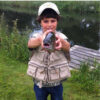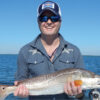Grilled whole fish is something I do a lot, and it’s easy to do, once you know a few tips and tricks.
Why grill whole fish? Several reasons. First, they look cool. Second, cooked properly, a grilled whole fish will stay together better than a grilled piece of fish. Third, you get crispy charred bits, which we all know and love.
Finally, and probably most importantly, you get to eat more of the fish by wasting less. You get the collar, the cheeks and those amazingly nutty tail fins! (I am serious, try a crispy tail fin and tell me I’m crazy. I dare you.)
What are the best fish to grill whole? Primarily bass-like fish that have substantial skeletons and relatively thick skins.
Some options I like: small striped bass (pictured on this page), Pacific rockfish, Atlantic black seabass, small snapper or freshwater bass, porgies, small carp, small drum, croakers, speckled sea trout, yellow perch, pompano, triggerfish, trout and even pink salmon.
If the fish are small enough to fit into a wok, I crispy fry them, Asian style. But summer is for grilling.
Here are some tips on making whole grilled fish:
Size. You will have to flip the fish on the grill, so I generally won’t grill a whole fish larger than about 20 inches.
They need to be scaled, gutted and gilled. Gills impart an off-taste to the fish and must be removed. Crispy fish skin is amazing.
Slice the fish several times perpendicular to the backbone—this opens the fish to heat better, so it cooks evenly. Three to five slashes are good.
Coat them in olive oil and salt only… for now.
Get a hot fire and have your grill grates very clean. Dirty grates = sticky fish. No one likes that.
Grill a bit longer than you think. Slightly overcooked grilled fish is better than undercooked; this is opposite of most indoor cooking.
Flipping a whole grilled fish is an art, but not a hard one to master. If your fish was well oiled, your grates are clean and you happen to have one of those long, flat spatulas that short-order cooks use to flip pancakes and eggs and burgers and such, you’re in business. Two regular spatulas work, too.
After the fish are grilled, I will often sauce them with an herb vinaigrette. I have a recipe for this method, using porgies and oregano oil, in my first cookbook, “Hunt, Gather, Cook: Finding the Forgotten Feast.”
Sometimes I stick with just salt, pepper and lemon. Sometimes I use that oregano oil or another herb-infused oil. Sometimes I season the fish with a basil vinaigrette I developed with my friend Elise over at Simply Recipes. Why basil? Because in summer, basil feels right. You could use any herb you want.
Or leave the sauce out completely.
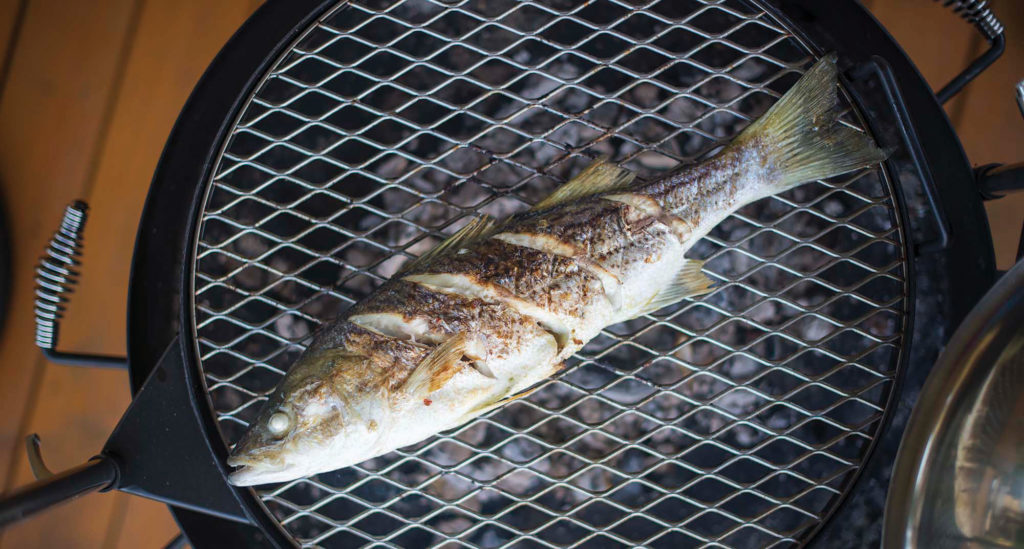
Grilled Whole Fish
Prep Time 20 mins
Cook Time 15 mins
Total Time 35 mins
1 or 2 whole fish, scaled, gutted and with gills removed
Olive oil
Salt
Freshly ground black pepper
Grilling a whole fish is not difficult, but there are a few tricks to doing it without having the fish stick to your grill grates. Any whole fish will do, but you generally want them less than about 20 inches long. Make sure they are well coated in oil, well salted and make sure your grill is nice and hot, and you will be fine.
1. Wash the fish well and make 3 to 5 slashes in the meat perpendicular to the backbone on each side of the fish. You are doing this to open the interior of the fish to the heat, so it will cook evenly. Make more slashes closer to the head, where the fish is thicker, than toward the tail, which cooks first. Snip off any sharp fins with kitchen shears or scissors if you want. Leave the tail, as it will crisp up and taste wonderfully nutty. Seriously. Try it.
2. Coat the fish with olive oil and salt it a little more than you think you ought to; salty fish tastes good! Let the fish sit at room temperature for 20 minutes to an hour.
3. Get your grill crazy hot, at least 500°F, and scrape the grill grates well to clean them. When you are ready to lay the fish down, dip a paper towel in some oil and grab it with tongs. Wipe down the grill with the oily towel and them immediately lay the fish down on the grill grates. Let them sizzle nicely for a minute or so.
4. Turn the heat down to medium and cover the grill if you have a gas grill, or just leave the fish on the open grill if you are using wood or charcoal and the grill is very hot. Let the fish cook for a total of 5 to 10 minutes on this side, depending on how thick it is. A general rule is a fish will need 10 minutes per inch of thickness. Estimate this thickness measuring to the fish’s spine – remember you are flipping the fish.
5. To turn the fish, have your tongs in your “off” hand and a big spatula in your good hand. Gently turn the fish over. It should come off the grates cleanly. If not, don’t force it. Let the fish back down and come back at it with the spatula, using pressure to pry it off the grates. You don’t want to pull the fish away from the grates and have half the skin and meat stick to the grill. Once the fish is flipped, let it cook for another 5 to 10 minutes.
6. Once the fish is ready—check by making sure the meat closest to the bone in the slash that is closest to the head of the fish is fully cooked—put it on a platter and serve, with a sauce or not.
One last thing: Make sure your fish are scaled, gutted and have their gills removed—you don’t want to eat scales, and gills can make the fish taste bitter, so cut them out with kitchen shears. Watch out! They are sharp.
About Hank Shaw
Hank Shaw is a chef, hunter, angler, forager and wild-foods expert constantly on the lookout for new things to gather, catch and eat. He is the author of four wild-game cookbooks: “Hunt, Gather, Cook: Finding the Forgotten Feast” (2011); “Duck, Duck, Goose: Recipes and Techniques for Ducks and Geese, both Wild and Domesticated” (2013); “Buck, Buck, Moose: Recipes and Techniques for Cooking Deer, Elk, Moose, Antelope and Other Antlered Things” (2016); and “Pheasant, Quail, Cottontail: Upland Birds and Small Game from Field to Feast” (2018).
Shaw stands at the forefront of the wild-foods movement, and his website Hunter Angler Gardener Cook (honest-food.net) is the internet’s largest source of tips, techniques and recipes for wild foods. From venison to wild mushrooms, waterfowl to upland game birds, saltwater and freshwater fish, seafood, and edible wild plants, food that you can’t buy in the store is Shaw’s specialty.
Hunter Angler Gardener Cook won the James Beard Award for Best Blog in 2013; the Beards are considered the Oscars of the food world. Shaw also won the International Association of Culinary Professionals (IACP) award for Best Blog in 2010 and 2011, and his work was featured in the 2012 and 2013 editions of “Best American Food Writing.”
Shaw has appeared on television shows ranging from Mike Rowe’s “Somebody’s Gotta Do It” on CNN, to Andrew Zimmern’s “Bizarre Foods” on Travel Channel, to Steven Rinella’s “Meateater” on Sportsman Channel. He has been featured in The New York Times, Chicago Tribune, the Washington Post, Field & Stream, CNN, NPR and similar outlets.
He hunts, fishes and forages near Sacramento, CA.
Photos by Holly A. Heyser

